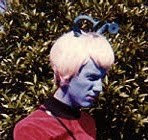Because this a clear example of an FAQ (Frequently Asked Question), I'm putting this example of Star Trek geekiness where I can find it easily for next time.
Someone over on TrekBBS just asked about the differences between airdate order, production order and stardate order when watching Star Trek DVDs...
For a long time, people didn't readily know the "production order" of TOS (The Original Series). The "Star Trek Concordance" by Bjo Trimble (and all other lists of the day) presented summaries of the the episodes of TOS and TAS as they had originally aired in Los Angeles, USA, and then tried an experiment by adding a second list: putting the stardates into order (which really only proved conclusively that stardates, particularly in TAS, were quite random, and prone to typographical errors).
Gene Roddenberry had gone to great pains to say that stardates were really just random numbers, at a whim of time and space irregularities, and only had to be progressing sensibly within an episode, but weirdly, they do often seem to have a weird connection to each other. And fans love weirdness.
TOS was usually made to be viewable in random order and, when the series went to US syndication in the 70s, US TV stations either stuck with original airdate order or total randomness. Then along came "Star Trek: The Motion Picture" - and Alan Asherman's "Star Trek Compendium". He had researched the production numbers and dates and, for the first time, many ST fans could see the order in which the episodes had been made. The TV order they'd all been used to had only came about due to such random factors as late SPFX on some episodes and/or network exec demands ("Give 'em a monster ep first up", ie. "The Man Trap".) When a few fans (and TV stations) started using this "new" order to screen episodes, it was noticed how a few continuity threads suddenly matched up. Uhura's gold uniform episodes suddenly ended up together, for example. "Where No Man Has Gone Before", the show's second pilot was not suddenly a confusing "flashback" episode, but more like an Episode 1.
With Filmation's animated "Star Trek" series (known as TAS), the airdate order in Los Angeles - and Bjo's Concordance - was different to the rest of the country. George Takei was running for local political office when TAS premiered, so a Takei-less episode of TAS had to be run on a certain week in LA, otherwise his opponents could have demanded "equal time" (22 minutes) from the station running it.
By the time of "Star Trek: The Next Generation" (and beyond), if an episode was running late due to tricky SPFX, or if episodes were shot out of order (ie. Denise Crosby making another episode after her on-screen death; or "Unification Part II" being made first to fit in with Nimoy's availability), the producers were able to tweak things to keep the screening order okay, continuity-wise. There are a few glitches they glossed over: originally, the realism of the holodeck scenario in "The Big Goodbye" was originally possible only because it had been upgraded by the Bynars in "11001001", but they realised they'd have to screen those episodes out of intended order, IIRC.
Anyway, if you want to recapture the viewing experience of the very first TOS fans, watch your TOS DVDs as presented, with "The Man Trap" first. Hop around your discs if you want production order instead. (The first DVD twinpacks, originally released in the US, had production order, and many TOS diehards - including the people preparing the DVD sets - thought that was a travesty!)
For the rest of Trek, just relax and let the DVD boxed sets screen you the eps as presented.
Friday, July 11, 2008
Subscribe to:
Post Comments (Atom)










No comments:
Post a Comment